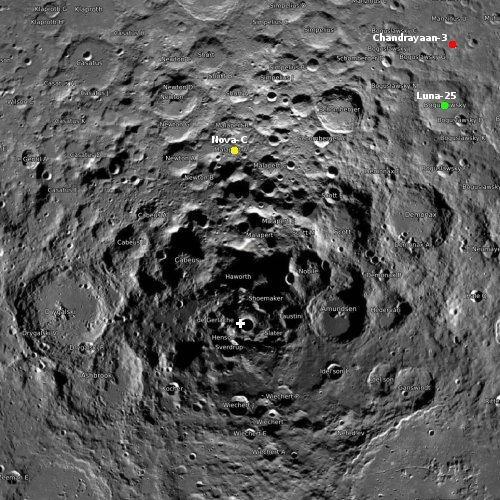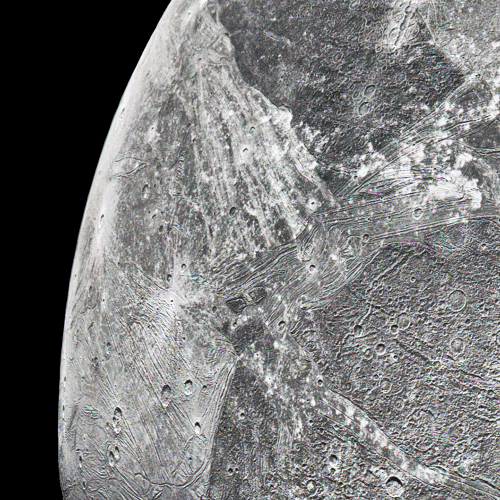Month: May 2023
May 31, 2023 Quick space links
Courtesy of BtB’s stringer Jay.
- Roscosmos proposes extending its astronaut barter deal with NASA
The current deal ends after four astronauts from each nation fly to ISS on the other nation’s rockets/capsules.
- ESA press release calls for private European companies to provide freighter service to ISS and future stations
This announcement is a followup on ESA’s new policy to emulate NASA by adopting my recommendations from my 2017 policy paper, Capitalism in Space by becoming a mere customer hiring its aerospace private sector rather than being the designer and builder of spacecraft and rockets.
- South Korea replaces Russia with Arianespace to launch an Earth observation satellite
The Arianespace press release is here. This switch is a direct result of Russia’s invasion of the Ukraine, and results in the loss of approximately $100 million in revenue.
- Spanish rocket startup PLD scrubs first suborbital test launch of its Miura-1 rocket due to high winds
No word on a new launch date.
- UAE touts its new planned asteroid mission
The details revealed in this week’s announcement are essentially the same as revealed on May 10th.
Courtesy of BtB’s stringer Jay.
- Roscosmos proposes extending its astronaut barter deal with NASA
The current deal ends after four astronauts from each nation fly to ISS on the other nation’s rockets/capsules.
- ESA press release calls for private European companies to provide freighter service to ISS and future stations
This announcement is a followup on ESA’s new policy to emulate NASA by adopting my recommendations from my 2017 policy paper, Capitalism in Space by becoming a mere customer hiring its aerospace private sector rather than being the designer and builder of spacecraft and rockets.
- South Korea replaces Russia with Arianespace to launch an Earth observation satellite
The Arianespace press release is here. This switch is a direct result of Russia’s invasion of the Ukraine, and results in the loss of approximately $100 million in revenue.
- Spanish rocket startup PLD scrubs first suborbital test launch of its Miura-1 rocket due to high winds
No word on a new launch date.
- UAE touts its new planned asteroid mission
The details revealed in this week’s announcement are essentially the same as revealed on May 10th.
Pushback: If the young are beginning to resist the leftist queer agenda, then there is real hope

“A little child shall lead them,” painting by James L. Johnson.
And a little child shall lead them: There appears to be increasing evidence that it isn’t just the parents that are becoming aware and opposed to the queer and Marxist agenda that the public schools and leftist governments have been force feeding down children’s throats for the past decade. It now appears the students themselves are beginning to rise up in rebellion.
This story from May 29, 2023 illustrates the point:
» Read more

“A little child shall lead them,” painting by James L. Johnson.
And a little child shall lead them: There appears to be increasing evidence that it isn’t just the parents that are becoming aware and opposed to the queer and Marxist agenda that the public schools and leftist governments have been force feeding down children’s throats for the past decade. It now appears the students themselves are beginning to rise up in rebellion.
This story from May 29, 2023 illustrates the point:
» Read more
Curiosity looks back again as it climbs higher onto Mount Sharp
After completing several weeks of drilling, Curiosity has once again started climbing the rocky rough slope of Mount Sharp in Gale Crater, working its way up into the giant slot canyon dubbed Gediz Vallis.
The panorama above, cropped, reduced, sharpened, and annotated to post here, was created from 31 pictures taken on May 30, 2023 by the rover’s right navigation camera. It looks back both at Curiosity’s past travels climbing Mount Sharp as well as the now increasingly distant floor and rim of Gale Crater. The rim is about 20-30 miles away.
On the overview map to the right, the blue dot marks Curiosity’s position when this panorama was taken, with the yellow lines indicating the approximate area covered. The white dotted line on both the panorama and map indicates the rover’s actual route, with the red dotted line its planned route.
Because of the steep rough terrain, the science team has shifted the rover a bit to the west as it climbs. It is going to be fascinating to watch how it manages this climb into Gediz Vallis, as it appears the terrain is going to get no less steep or rough.
After completing several weeks of drilling, Curiosity has once again started climbing the rocky rough slope of Mount Sharp in Gale Crater, working its way up into the giant slot canyon dubbed Gediz Vallis.
The panorama above, cropped, reduced, sharpened, and annotated to post here, was created from 31 pictures taken on May 30, 2023 by the rover’s right navigation camera. It looks back both at Curiosity’s past travels climbing Mount Sharp as well as the now increasingly distant floor and rim of Gale Crater. The rim is about 20-30 miles away.
On the overview map to the right, the blue dot marks Curiosity’s position when this panorama was taken, with the yellow lines indicating the approximate area covered. The white dotted line on both the panorama and map indicates the rover’s actual route, with the red dotted line its planned route.
Because of the steep rough terrain, the science team has shifted the rover a bit to the west as it climbs. It is going to be fascinating to watch how it manages this climb into Gediz Vallis, as it appears the terrain is going to get no less steep or rough.
North Korean rocket fails in attempt to put spy satellite into orbit
In North Korea’s first attempt today to place a spy satellite into orbit since 2016, the rocket failed shortly after launch, dropping into the ocean.
But the rocket lost thrust and plunged into the sea with its satellite payload, the official Korean Central News Agency reported. It added that authorities would investigate the “serious defects” revealed by the launch and conduct another test as soon as possible.
South Korea’s military said it had managed to locate and salvage a portion of the suspected debris. It released images showing a large barrel-like metal structure with thin pipes and wires at the bottom, which experts said might be a liquid fuel tank.
The U.S., Japan, and South Korea all condemned the launch as violating UN sanctions, as did the UN’s secretary-general.
The recovery by South Korea could yield a great deal of technical information about North Korea’s rocketry and missile program.
In North Korea’s first attempt today to place a spy satellite into orbit since 2016, the rocket failed shortly after launch, dropping into the ocean.
But the rocket lost thrust and plunged into the sea with its satellite payload, the official Korean Central News Agency reported. It added that authorities would investigate the “serious defects” revealed by the launch and conduct another test as soon as possible.
South Korea’s military said it had managed to locate and salvage a portion of the suspected debris. It released images showing a large barrel-like metal structure with thin pipes and wires at the bottom, which experts said might be a liquid fuel tank.
The U.S., Japan, and South Korea all condemned the launch as violating UN sanctions, as did the UN’s secretary-general.
The recovery by South Korea could yield a great deal of technical information about North Korea’s rocketry and missile program.
Russia delays launch of its Luna-25 mission one month to August
Russia today announced that it is delaying the July launch of its Luna-25 mission to August.
No reason for the delay was revealed. The mission itself has been under development for almost a quarter century, with numerous delays. It will be the first lunar probe by Russia since the 1970s.
The lunar mission will be launched atop a Soyuz-2.1b carrier rocket with a Fregat booster from the Vostochny space center in the Russian Far East. Under the lunar project, the Luna-25 automatic station will be launched for studies in the area of the lunar south pole. The lander is set to touch down in the area of the Boguslawsky crater.
The green dot on the map shows this crater, with the white cross the Moon’s south pole. The other two missions are also targeting launches this summer, with Chandrayaan-3 set for a July launch and Nova-C in late September.
Russia today announced that it is delaying the July launch of its Luna-25 mission to August.
No reason for the delay was revealed. The mission itself has been under development for almost a quarter century, with numerous delays. It will be the first lunar probe by Russia since the 1970s.
The lunar mission will be launched atop a Soyuz-2.1b carrier rocket with a Fregat booster from the Vostochny space center in the Russian Far East. Under the lunar project, the Luna-25 automatic station will be launched for studies in the area of the lunar south pole. The lander is set to touch down in the area of the Boguslawsky crater.
The green dot on the map shows this crater, with the white cross the Moon’s south pole. The other two missions are also targeting launches this summer, with Chandrayaan-3 set for a July launch and Nova-C in late September.
Spain becomes 25th nation to sign Artemis Accords
In a ceremony yesterday in Spain, that country became the 25th nation to sign the Artemis Accords, a bi-lateral agreement with the United States that was designed during the Trump administration to act as a work around to the limitations to private enterprise in space created by the Outer Space Treaty.
The full list of signatories so far: Australia, Bahrain, Brazil, Canada, Columbia, Czech Republic, France, Israel, Italy, Japan, Luxembourg, Mexico, New Zealand, Nigeria, Poland, Romania, Rwanda, Saudi Arabia, Singapore, South Korea, Spain, the United Kingdom, the United Arab Emirates, the Ukraine, and the United States.
This alliance gives the United States a great deal of leverage in establishing legal policy, if it is used as originally intended. It however at present remains unclear if the Biden administration intends to do so, considering its general hostility to the private sector and freedom.
In a ceremony yesterday in Spain, that country became the 25th nation to sign the Artemis Accords, a bi-lateral agreement with the United States that was designed during the Trump administration to act as a work around to the limitations to private enterprise in space created by the Outer Space Treaty.
The full list of signatories so far: Australia, Bahrain, Brazil, Canada, Columbia, Czech Republic, France, Israel, Italy, Japan, Luxembourg, Mexico, New Zealand, Nigeria, Poland, Romania, Rwanda, Saudi Arabia, Singapore, South Korea, Spain, the United Kingdom, the United Arab Emirates, the Ukraine, and the United States.
This alliance gives the United States a great deal of leverage in establishing legal policy, if it is used as originally intended. It however at present remains unclear if the Biden administration intends to do so, considering its general hostility to the private sector and freedom.
SpaceX launches another 52 Starlink satellites
SpaceX tonight successfully launched another 52 Starlink satellites, using its Falcon 9 rocket lifting off from Vandenberg in California.
The first stage completed its fourteenth flight, landing successfully on a drone ship in the Pacific. The fairing halves completed their fifth and seventh flights respectively.
The leaders in the 2023 launch race:
36 SpaceX
20 China
8 Russia
5 Rocket Lab
American private enterprise now leads China 41 to 20 in the national rankings, and the entire world combined 41 to 36. SpaceX alone is now tied with the rest of the world combined 36 to 36, but trails the entire world including American companies 36 to 41.
SpaceX tonight successfully launched another 52 Starlink satellites, using its Falcon 9 rocket lifting off from Vandenberg in California.
The first stage completed its fourteenth flight, landing successfully on a drone ship in the Pacific. The fairing halves completed their fifth and seventh flights respectively.
The leaders in the 2023 launch race:
36 SpaceX
20 China
8 Russia
5 Rocket Lab
American private enterprise now leads China 41 to 20 in the national rankings, and the entire world combined 41 to 36. SpaceX alone is now tied with the rest of the world combined 36 to 36, but trails the entire world including American companies 36 to 41.
AX-2 commercial passenger flight to ISS splashes down safely
Axiom’s second commercial passenger flight to ISS, dubbed AX-2, successfully splashed down in the Gulf of Mexico a little after 11 pm (Eastern) tonight after spending eight days in space.
Recovery efforts of the Freedom capsule are still underway by SpaceX crews. It is necessary again to emphasize that this is a private mission, launched by a private company in a privately owned capsule for a private company and private passengers. The only government involvement was when the capsule was docked to ISS and the crew was on the station.
Axiom’s second commercial passenger flight to ISS, dubbed AX-2, successfully splashed down in the Gulf of Mexico a little after 11 pm (Eastern) tonight after spending eight days in space.
Recovery efforts of the Freedom capsule are still underway by SpaceX crews. It is necessary again to emphasize that this is a private mission, launched by a private company in a privately owned capsule for a private company and private passengers. The only government involvement was when the capsule was docked to ISS and the crew was on the station.
Ray Bolger & Judy Garland – If I Only Had a Brain
An evening pause: From the 1939 MGM classic, The Wizard of Oz, when Hollywood still made films in which the witches were the bad guys, not the heroes.
Hat tip Judd Clark.
May 30, 2023 Quick space links
Courtesy of BtB’s stringer Jay.
- Dawn Aerospace: now producing 2 B20 satellite thrusters per week, having shipped 100 to customers
More information about the thruster here.
- PLD’s suborbital Miura-1 set to launch later today on first test flight from Spain
The live stream is available here, beginning at 8:30 pm (Pacific).
- New crew welcomed on China’s Tiangong-3 space station
The two crews will remain together on the station for the next five days, when the old crew will return to Earth. Video of the docking can be seen here.
- China announces plan to land humans on Moon before 2030
The officials claim they are working full speed on their manned lunar lander, the rocket, lunar spacesuits, etc. I have no idea if they will meet the date, but I agree with Jay, who wrote, “I bet they beat Blue Moon.”
Courtesy of BtB’s stringer Jay.
- Dawn Aerospace: now producing 2 B20 satellite thrusters per week, having shipped 100 to customers
More information about the thruster here.
- PLD’s suborbital Miura-1 set to launch later today on first test flight from Spain
The live stream is available here, beginning at 8:30 pm (Pacific).
- New crew welcomed on China’s Tiangong-3 space station
The two crews will remain together on the station for the next five days, when the old crew will return to Earth. Video of the docking can be seen here.
- China announces plan to land humans on Moon before 2030
The officials claim they are working full speed on their manned lunar lander, the rocket, lunar spacesuits, etc. I have no idea if they will meet the date, but I agree with Jay, who wrote, “I bet they beat Blue Moon.”
New data gives the same result as old data: Like the flu, COVID hurt NO ONE who was young and healthy

Trofim Lysenko (on the left), the person now considered the ideal
scientific model by health officials, preaching to Stalin as he destroyed
Soviet plant research, persecuted anyone who disagreed with him,
and caused famines that killed millions.
New data from Israel has now confirmed what was obvious almost from the beginning, that COVID-19 was nothing more than a variation of the flu, a danger only to the elderly and the chronically sick.
According to newly revealed Israeli Ministry of Health data, during the entire epidemic there were zero deaths (that’s 0, nil, none, naught, zilch, null) from COVID to anyone under fifty who was of average and reasonable health.
Zero healthy individuals under the age of 50 have died of COVID-19 in Israel, according to newly released data. “Zero deceased of 18–49 years of age with no underlying morbidities,” the Israel Ministry of Health (MOH) said in response to a formal request from an attorney. Officials noted that the statement only applies to COVID-19 deaths where the MOH conducted an epidemiological investigation and had received information about the underlying diseases.
“Zero is a very, very clear number, and cannot be subject to interpretation,” Yoav Yehezkelli, a specialist in internal medicine and medical management, and former lecturer in the Department of Emergency and Disaster Management at Tel Aviv University in Israel, told The Epoch Times.
“Why were all the extreme measures of school closures, vaccination of children, and lockdowns needed?” he added. [emphasis mine]
This data simply confirms what numerous health experts unwilling to play political games with the data have said from the beginning, that COVID was essentially similar to the flu, harmless to healthy people and only a risk to the elderly and those with serious chronic health issues. Just like the flu, if you are healthy you have no reason to fear it, and in fact, you should be unbothered about getting it as it will give you natural immunity, thus making the spread of the virus more difficult and reducing the risk to those whom the virus (and the flu) could kill.
Trump — along with a lot of other Washington officials — proved this point when they all got COVID in October 2020 and quickly recovered. As I wrote then:
» Read more
A typical glacier, on Mars

The cool image from Mars to the right, rotated, cropped, reduced, and sharpened to post here, provides us a good illustration of the lineated grooves that are typically seen on the surface of valley-confined glaciers, both on Earth and on Mars, and are also seen on the patched, grooved surface of Ganymede.
The picture was taken on March 13, 2023 by the high resolution camera on Mars Reconnaissance Orbiter (MRO), and shows what appears to be a glacier flowing through a constriction. The arrow indicates the direction of the downhill grade.
The location, indicated by the white dot inside the inset on the overview map above, marks the location, in the western end of the 2,000 long northern mid-latitude strip on Mars I dub glacier country. In these three mensae regions (Deuteronilus, Protonilus, and Nilosyrtis) of chaos terrain practically every high resolution image shows features that resemble glaciers.
In this case, the glacial flow appears to be draining from a 10-mile-wide ponded circular valley though a narrow gap.

The cool image from Mars to the right, rotated, cropped, reduced, and sharpened to post here, provides us a good illustration of the lineated grooves that are typically seen on the surface of valley-confined glaciers, both on Earth and on Mars, and are also seen on the patched, grooved surface of Ganymede.
The picture was taken on March 13, 2023 by the high resolution camera on Mars Reconnaissance Orbiter (MRO), and shows what appears to be a glacier flowing through a constriction. The arrow indicates the direction of the downhill grade.
The location, indicated by the white dot inside the inset on the overview map above, marks the location, in the western end of the 2,000 long northern mid-latitude strip on Mars I dub glacier country. In these three mensae regions (Deuteronilus, Protonilus, and Nilosyrtis) of chaos terrain practically every high resolution image shows features that resemble glaciers.
In this case, the glacial flow appears to be draining from a 10-mile-wide ponded circular valley though a narrow gap.
The grooved surface of Ganymede
Cool image time! The picture to the right, reduced to post here, was taken on June 7, 2021 when the Jupiter orbiter Juno did a close flyby of the moon Ganymede, taking four pictures.
Citizen scientists Gerald Eichstädt and Thomas Thomopoulos have now reprocessed parts of those images to bring out the details more clearly (the other new versions available here, and here).
I have chosen to highlight the picture to the right however because it so clearly shows the puzzling grooves that cover much of Ganymede’s surface. While these parallel grooves in many ways mimic the grooves often seen on top of valley glaciers on Earth and Mars, on Ganymede they do not follow any valley floor. Instead, they form patches of parallel grooves that travel in completely different directions, depending on the patch. At the moment their origin is not understood.
These grooves are one of the mysteries that Europe’s Juice probe will attempt to solve when it arrives in orbit around Jupiter in 2031.
Cool image time! The picture to the right, reduced to post here, was taken on June 7, 2021 when the Jupiter orbiter Juno did a close flyby of the moon Ganymede, taking four pictures.
Citizen scientists Gerald Eichstädt and Thomas Thomopoulos have now reprocessed parts of those images to bring out the details more clearly (the other new versions available here, and here).
I have chosen to highlight the picture to the right however because it so clearly shows the puzzling grooves that cover much of Ganymede’s surface. While these parallel grooves in many ways mimic the grooves often seen on top of valley glaciers on Earth and Mars, on Ganymede they do not follow any valley floor. Instead, they form patches of parallel grooves that travel in completely different directions, depending on the patch. At the moment their origin is not understood.
These grooves are one of the mysteries that Europe’s Juice probe will attempt to solve when it arrives in orbit around Jupiter in 2031.
SpaceX confirms Starship prototype to fly on next Superheavy test flight
SpaceX has confirmed that it will use Starship prototype #25 to fly on top of Superheavy prototype #9 on the next orbital test flight.
Starship #25 does not include a lot of the upgrades that have been installed on later Starship prototypes, but by using it SpaceX tells us its focus on that next orbital test flight will be to test Superheavy. Using this less capable Starship gets it used and out of the way so that the kinks in Superheavy can more quickly be worked out.
It also means SpaceX’s prime focus on that second flight will not be reaching orbit, though the company will try nonetheless.
The article at the link also notes that this next orbital test cannot take place any sooner than August, based simply on engineering requirements.
Ship 25 is now at the launch site and awaiting a six-engine static fire test, with Elon Musk noting the pad modifications should be complete in a month, ahead of another month of testing before the next test flight.
This gives the FAA two full months to approve the launch license. I predict however that come August, that launch license will still not be approved, and we will still have no clear idea of when that approval will come. Nor should we be surprised if approval does not come before the end of this year.
SpaceX has confirmed that it will use Starship prototype #25 to fly on top of Superheavy prototype #9 on the next orbital test flight.
Starship #25 does not include a lot of the upgrades that have been installed on later Starship prototypes, but by using it SpaceX tells us its focus on that next orbital test flight will be to test Superheavy. Using this less capable Starship gets it used and out of the way so that the kinks in Superheavy can more quickly be worked out.
It also means SpaceX’s prime focus on that second flight will not be reaching orbit, though the company will try nonetheless.
The article at the link also notes that this next orbital test cannot take place any sooner than August, based simply on engineering requirements.
Ship 25 is now at the launch site and awaiting a six-engine static fire test, with Elon Musk noting the pad modifications should be complete in a month, ahead of another month of testing before the next test flight.
This gives the FAA two full months to approve the launch license. I predict however that come August, that launch license will still not be approved, and we will still have no clear idea of when that approval will come. Nor should we be surprised if approval does not come before the end of this year.
Webb detects large water plume released from Saturn’s moon Enceladus
Using the infrared cameras on the Webb Space Telescope, astronomers have detected a surprisingly long and large plume of water vapor erupting from the tiger stripe fractures on Saturn’s moon Enceladus that scientists for years have detected vapor plumes.
The false color image to the right shows that plume.
A water vapor plume from Saturn’s moon Enceladus spanning more than 6,000 miles – nearly the distance from Los Angeles, California to Buenos Aires, Argentina – has been detected by researchers using NASA’s James Webb Space Telescope. Not only is this the first time such a water emission has been seen over such an expansive distance, but Webb is also giving scientists a direct look, for the first time, at how this emission feeds the water supply for the entire system of Saturn and its rings.
…The length of the plume was not the only characteristic that intrigued researchers. The rate at which the water vapor is gushing out, about 79 gallons per second, is also particularly impressive. At this rate, you could fill an Olympic-sized swimming pool in just a couple of hours. In comparison, doing so with a garden hose on Earth would take more than 2 weeks.
Though that rate of release sounds large, we must remember it is being released from a moon 313 miles across. From that perspective the rate of flow is quite reasonable.
Using the infrared cameras on the Webb Space Telescope, astronomers have detected a surprisingly long and large plume of water vapor erupting from the tiger stripe fractures on Saturn’s moon Enceladus that scientists for years have detected vapor plumes.
The false color image to the right shows that plume.
A water vapor plume from Saturn’s moon Enceladus spanning more than 6,000 miles – nearly the distance from Los Angeles, California to Buenos Aires, Argentina – has been detected by researchers using NASA’s James Webb Space Telescope. Not only is this the first time such a water emission has been seen over such an expansive distance, but Webb is also giving scientists a direct look, for the first time, at how this emission feeds the water supply for the entire system of Saturn and its rings.
…The length of the plume was not the only characteristic that intrigued researchers. The rate at which the water vapor is gushing out, about 79 gallons per second, is also particularly impressive. At this rate, you could fill an Olympic-sized swimming pool in just a couple of hours. In comparison, doing so with a garden hose on Earth would take more than 2 weeks.
Though that rate of release sounds large, we must remember it is being released from a moon 313 miles across. From that perspective the rate of flow is quite reasonable.
Chinese launch yesterday set record for number of humans in space
The launch yesterday of three Chinese astronauts to that country’s Tiangong-3 space station established a new record, seventeen, for the number of humans in space.
The launch of the next crew to China’s Tiangong space station late Monday (U.S. time) added three astronauts to the population of humans in space, which reached a record number of 17 people in orbit — six Chinese citizens, five Americans, three Russians, two Saudis, and one Emirati astronaut.
The arrival of Chinese astronauts Jing Haipeng, Zhu Yangzhu, and Gai Haichao in space following their launch atop a Long March rocket broke the previous record of 14 people in orbit at one time.
Meanwhile, the four-person crew of the commercial AX-2 mission to ISS, has undocked from ISS, with SpaceX’s Freedom capsule expected to splashdown in the Gulf of Mexico at 11:09 pm (Eastern) tonight.
The launch yesterday of three Chinese astronauts to that country’s Tiangong-3 space station established a new record, seventeen, for the number of humans in space.
The launch of the next crew to China’s Tiangong space station late Monday (U.S. time) added three astronauts to the population of humans in space, which reached a record number of 17 people in orbit — six Chinese citizens, five Americans, three Russians, two Saudis, and one Emirati astronaut.
The arrival of Chinese astronauts Jing Haipeng, Zhu Yangzhu, and Gai Haichao in space following their launch atop a Long March rocket broke the previous record of 14 people in orbit at one time.
Meanwhile, the four-person crew of the commercial AX-2 mission to ISS, has undocked from ISS, with SpaceX’s Freedom capsule expected to splashdown in the Gulf of Mexico at 11:09 pm (Eastern) tonight.
China sends a new crew to its Tiangong-3 space station
Using its Long March 2F rocket, China today (May 30th in China) sent a new three-man crew to its Tiangong-3 space station for a five month mission.
The launch was from the Juiquan spaceport in the interior of China, so both the four side strap-on boosters as well as the core stage crashed somewhere in China. No word of any damage or injuries.
The Shenzhou capsule is expected to dock with the station about six hours after launch. The old crew’s stay will overlap with this new crew for a short time before returning to Earth.
The leaders in the 2023 launch race:
35 SpaceX
20 China
8 Russia
5 Rocket Lab
American private enterprise still leads China 40 to 20 in the national rankings, and the entire world combined 40 to 36. SpaceX alone now trials the rest of the world combined 35 to 36, but trails the entire world including American companies 35 to 41.
Using its Long March 2F rocket, China today (May 30th in China) sent a new three-man crew to its Tiangong-3 space station for a five month mission.
The launch was from the Juiquan spaceport in the interior of China, so both the four side strap-on boosters as well as the core stage crashed somewhere in China. No word of any damage or injuries.
The Shenzhou capsule is expected to dock with the station about six hours after launch. The old crew’s stay will overlap with this new crew for a short time before returning to Earth.
The leaders in the 2023 launch race:
35 SpaceX
20 China
8 Russia
5 Rocket Lab
American private enterprise still leads China 40 to 20 in the national rankings, and the entire world combined 40 to 36. SpaceX alone now trials the rest of the world combined 35 to 36, but trails the entire world including American companies 35 to 41.
Sinking the Bismarck
An evening pause: For Memorial Day, let’s have some history recounting one of the most important Atlantic naval battles of World War II, which took place 82 years ago this weekend. If the Bismarck had been successful in getting out into the Atlantic to attack convoys, Great Britain could very well have been starved into submission.
Hat tip Mike Nelson, who adds, “The ravages of WWII have faded from memory but we should never forget. Too many paid the price for the freedoms we so blithely take for granted.”
Cracking pedestal crater near Mars’ north pole
Cool image time! The picture to the right, cropped, reduced, and sharpened to post here, was taken on March 18, 2023 by the high resolution camera on Mars Reconnaissance Orbiter (MRO). I have also rotated it so that north is to the top.
Labeled a “terrain sample” by the camera team, this picture was likely taken not as part of any specific research project, but to fill a gap in the camera’s schedule so as to maintain its proper temperature. As usual, when the camera team needs to do this, they try to pick a target of interest. Sometimes they succeed, sometimes not.
In this case, the picture is of a location only about 800 miles from the Martian north pole, on the northern lowland plains. While the section shown to the right focuses on the largest crater, the full picture includes a few others, all of which appear to have their interior floors cracking in the same way, and all appear to be pedestal craters, sitting above the surrounding terrain, though by not as much.
» Read more
Cool image time! The picture to the right, cropped, reduced, and sharpened to post here, was taken on March 18, 2023 by the high resolution camera on Mars Reconnaissance Orbiter (MRO). I have also rotated it so that north is to the top.
Labeled a “terrain sample” by the camera team, this picture was likely taken not as part of any specific research project, but to fill a gap in the camera’s schedule so as to maintain its proper temperature. As usual, when the camera team needs to do this, they try to pick a target of interest. Sometimes they succeed, sometimes not.
In this case, the picture is of a location only about 800 miles from the Martian north pole, on the northern lowland plains. While the section shown to the right focuses on the largest crater, the full picture includes a few others, all of which appear to have their interior floors cracking in the same way, and all appear to be pedestal craters, sitting above the surrounding terrain, though by not as much.
» Read more
How real is the Texas legislature’s proposed ban on the racist “Diversity, Equity, and Inclusion” programs at colleges?

Failure theater? This week the Texas legislature passed a proposed ban on race-based “Diversity, Equity, and Inclusion” (DEI) programs at its public colleges, requiring all such offices be closed within six months with the staff of such offices terminated.
The final legislation says universities cannot create diversity offices, hire employees to conduct DEI work, or require any DEI training as a condition for being hired by or admitted to the university. All hiring practices must be “color-blind and sex-neutral.” The bill would also prohibit universities from asking job candidates to provide written answers about how they consider diversity in their work or sharing how they would work with diverse populations, commonly known as diversity statements. Critics have equated diversity statements with ideological oaths, while supporters say they help ensure job candidates are prepared to support students from all backgrounds.
The legislation says university governing boards must adopt policies to discipline employees who violate these rules. Under the final version of the draft, university leaders cannot spend state money until they have declared to the state they are in line with the new law.
The bill still has to be signed by Texas’ Republican governor Greg Abbott, but that signature is expected.
Will this ban work? » Read more
China unveils next Shenzhou launch date and crew to its space station
China today revealed the next three-man crew to occupy its Tiangong-3 space station, with a planned launch in a Shenzhou crew capsule targeting May 30, 2023, Chinese time.
Because of time differences, that launch will occur tonight at 6:28 pm tonight, Pacific time. The rocket will be a Long March 2F taking off from China’s western interior Jiuquan spaceport. The rocket’s lower stages will therefore crash somewhere in China.
The crew will remain on board the station for five months, and with one astronaut the first Chinese to fly in space four times.
China today revealed the next three-man crew to occupy its Tiangong-3 space station, with a planned launch in a Shenzhou crew capsule targeting May 30, 2023, Chinese time.
Because of time differences, that launch will occur tonight at 6:28 pm tonight, Pacific time. The rocket will be a Long March 2F taking off from China’s western interior Jiuquan spaceport. The rocket’s lower stages will therefore crash somewhere in China.
The crew will remain on board the station for five months, and with one astronaut the first Chinese to fly in space four times.
North Korea notifies Japan of orbital rocket launch; Japan and South Korea protest
North Korea today sent a notification to Japan’s coast guard announcing a May 31st to June 1st launch window for an orbital rocket launch aimed at placing a military reconnaissance satellite into orbit.
Japan’s coast guard said North Korean waterway authorities revealed that the launch window was between May 31 and June 11 and that the launch may affect waters in the Yellow Sea, East China Sea and east of the Philippines’ Luzon Island.
A safety warning was issued by Japan’s coast guard for ships in the area on those dates due to the possible dangers of falling debris. The coast guard coordinates and distributes maritime safety information in East Asia, which is most likely why it received North Korea’s notice.
For North Korea to launch a satellite into space, it would need to use long-range missile technology banned by U.N. Security Council resolutions. The country’s previous launches of Earth observation satellites were viewed as missile tests in disguise.
Both Japan and South Korea have protested, saying this launch would violate UN sanctions, with one Japanese official claiming that country would shoot it down if it crossed over its territory.
It is unknown if Japan has the military capability to shoot down a rocket in flight. It has never tested such technology. North Korea meanwhile has done numerous suborbital missile tests in the last two years, and has three times in the past launched small satellites into orbit, the last time in 2016.
North Korea today sent a notification to Japan’s coast guard announcing a May 31st to June 1st launch window for an orbital rocket launch aimed at placing a military reconnaissance satellite into orbit.
Japan’s coast guard said North Korean waterway authorities revealed that the launch window was between May 31 and June 11 and that the launch may affect waters in the Yellow Sea, East China Sea and east of the Philippines’ Luzon Island.
A safety warning was issued by Japan’s coast guard for ships in the area on those dates due to the possible dangers of falling debris. The coast guard coordinates and distributes maritime safety information in East Asia, which is most likely why it received North Korea’s notice.
For North Korea to launch a satellite into space, it would need to use long-range missile technology banned by U.N. Security Council resolutions. The country’s previous launches of Earth observation satellites were viewed as missile tests in disguise.
Both Japan and South Korea have protested, saying this launch would violate UN sanctions, with one Japanese official claiming that country would shoot it down if it crossed over its territory.
It is unknown if Japan has the military capability to shoot down a rocket in flight. It has never tested such technology. North Korea meanwhile has done numerous suborbital missile tests in the last two years, and has three times in the past launched small satellites into orbit, the last time in 2016.
India’s space agency ISRO launches GPS-type satellite
India’s space agency ISRO today successfully used its GSLV rocket to place the first of a new constellation of that country’s second generation GPS-type satellites into geosynchronous orbit, lifting off from its Sriharikota east coast spaceport.
This was India’s fourth successful launch in 2023, matching its entire total last year. It appears that country has finally recovered from its panic during COVID.
The leader board for the 2023 launch race remains the same:
35 SpaceX
19 China
8 Russia
5 Rocket Lab
American private enterprise still leads China 40 to 19 in the national rankings, and the entire world combined 40 to 35. SpaceX alone is now tied with the rest of the world combined 35 to 35, but trails the entire world including American companies 35 to 40.
India’s space agency ISRO today successfully used its GSLV rocket to place the first of a new constellation of that country’s second generation GPS-type satellites into geosynchronous orbit, lifting off from its Sriharikota east coast spaceport.
This was India’s fourth successful launch in 2023, matching its entire total last year. It appears that country has finally recovered from its panic during COVID.
The leader board for the 2023 launch race remains the same:
35 SpaceX
19 China
8 Russia
5 Rocket Lab
American private enterprise still leads China 40 to 19 in the national rankings, and the entire world combined 40 to 35. SpaceX alone is now tied with the rest of the world combined 35 to 35, but trails the entire world including American companies 35 to 40.
SpaceX launches Arabsat communications satellite
SpaceX early today launched an Arabsat geosynchronous communications satellite into orbit, using its Falcon 9 rocket lifting off from Cape Canaveral.
The first stage successfully completed its fourteenth flight, landing on a drone ship in the Atlantic. The fairing halves completed their eighth and ninth flights respectively.
The leaders in the 2023 launch race:
35 SpaceX
19 China
8 Russia
5 Rocket Lab
American private enterprise now leads China 40 to 19 in the national rankings, and the entire world combined 40 to 34. SpaceX alone leads the rest of the world combined 35 to 34, but trails the entire world including American companies 35 to 39.
SpaceX early today launched an Arabsat geosynchronous communications satellite into orbit, using its Falcon 9 rocket lifting off from Cape Canaveral.
The first stage successfully completed its fourteenth flight, landing on a drone ship in the Atlantic. The fairing halves completed their eighth and ninth flights respectively.
The leaders in the 2023 launch race:
35 SpaceX
19 China
8 Russia
5 Rocket Lab
American private enterprise now leads China 40 to 19 in the national rankings, and the entire world combined 40 to 34. SpaceX alone leads the rest of the world combined 35 to 34, but trails the entire world including American companies 35 to 39.
May 26, 2023 Zimmerman/Batchelor podcast
Embedded below the fold in two parts.
To listen to all of John Batchelor’s podcasts, go here.
» Read more
Embedded below the fold in two parts.
To listen to all of John Batchelor’s podcasts, go here.
» Read more
How 500 horses get to Mackinac Island each spring
An evening pause: As noted at this website:
The island was America’s second national park (after Yellowstone National Park) for 20 years and has been the state of Michigan’s first state park. The island has had a ban on automobiles since the earliest days and still has the only highway in the nation where cars are banned.
Apparently, during the winter the horses are taken to the mainland for their benefit, and then returned in the spring in preparation for the summer tourism season. As this is the Friday of Memorial Day weekend, the start of the summer season, this seems most appropriate for tonight.
Hat tip Wayne DeVette.
Russia launches radar imaging satellite
Russia today used its Soyuz-2 rocket to place into orbit a radar imaging satellite, lifting off from its Vostochny spaceport in the far east.
The leaders in the 2023 launch race:
34 SpaceX
19 China
8 Russia
5 Rocket Lab
American private enterprise still leads China 39 to 19 in the national rankings, and the entire world combined 39 to 34.
Russia today used its Soyuz-2 rocket to place into orbit a radar imaging satellite, lifting off from its Vostochny spaceport in the far east.
The leaders in the 2023 launch race:
34 SpaceX
19 China
8 Russia
5 Rocket Lab
American private enterprise still leads China 39 to 19 in the national rankings, and the entire world combined 39 to 34.
May 26, 2023 Quick space links
Courtesy of BtB’s stringer Jay.
- The flight path taken by Hakuto-R1 as it entered Atlas Crater to attempt its lunar landing
According to the investigation, the software problem occurred as it flew over the north rim of the crater, causing later altitude data to be measured inaccurately.
- Ispace says Hakuto-R1 mission was insured
The link refers to “liability insurance”, which usually covers injury to yourself and others. It is unclear if Ispace’s insurance covered property loss.
- Blue Origin expanding its Alabama rocket facility for the third time
The local city council approved the sale of almost fifteen acres to the company. No word however if this means rockets and engines will actually finally appear from the factory.
- China touts the upgrades on its next six manned Shenzhou capsules
The upgrades apparently include more parts made domestically plus an upgraded control panel.
- Juice team completes full deployment of spacecraft, declaring it in “full flight configuration”
This last deployment involved the opening and positioning of several sensors on the spacecraft’s boom
Courtesy of BtB’s stringer Jay.
- The flight path taken by Hakuto-R1 as it entered Atlas Crater to attempt its lunar landing
According to the investigation, the software problem occurred as it flew over the north rim of the crater, causing later altitude data to be measured inaccurately.
- Ispace says Hakuto-R1 mission was insured
The link refers to “liability insurance”, which usually covers injury to yourself and others. It is unclear if Ispace’s insurance covered property loss.
- Blue Origin expanding its Alabama rocket facility for the third time
The local city council approved the sale of almost fifteen acres to the company. No word however if this means rockets and engines will actually finally appear from the factory.
- China touts the upgrades on its next six manned Shenzhou capsules
The upgrades apparently include more parts made domestically plus an upgraded control panel.
- Juice team completes full deployment of spacecraft, declaring it in “full flight configuration”
This last deployment involved the opening and positioning of several sensors on the spacecraft’s boom
A fractured spot in Mars’ northern lowland plains
Cool image time! The picture to the right, cropped, reduced, and sharpened to post here, was taken on February 16, 2023 by the high resolution camera on Mars Reconnaissance Orbiter (MRO). It shows a pockmarked flat plain with a scattering of meandering hollows, each filled with ripple sand dunes that make these depressions resemble at first glance the tracks of tires.
Obviously, we are not looking at evidence of a past giant vehicle moving across the ground on Mars. The MRO science team labels these “fractures,” suggesting some past geological process caused the surface to crack in this manner, with those cracks widening with time due to erosion or sublimation.
The location of course tells us something about that process.
» Read more
Cool image time! The picture to the right, cropped, reduced, and sharpened to post here, was taken on February 16, 2023 by the high resolution camera on Mars Reconnaissance Orbiter (MRO). It shows a pockmarked flat plain with a scattering of meandering hollows, each filled with ripple sand dunes that make these depressions resemble at first glance the tracks of tires.
Obviously, we are not looking at evidence of a past giant vehicle moving across the ground on Mars. The MRO science team labels these “fractures,” suggesting some past geological process caused the surface to crack in this manner, with those cracks widening with time due to erosion or sublimation.
The location of course tells us something about that process.
» Read more








